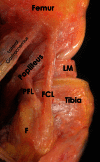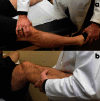Posterolateral Corner of the Knee: Current Concepts
- PMID: 27200384
- PMCID: PMC4852053
Posterolateral Corner of the Knee: Current Concepts
Abstract
Injuries to the posterolateral corner (PLC) comprise a significant portion of knee ligament injuries. A high index of suspicion is necessary when evaluating the injured knee to detect these sometimes occult injuries. Moreover, a thorough physical examination and a comprehensive review of radiographic studies are necessary to identify these injuries. In this sense, stress radiographs can help to objectively determine the extent of these lesions. Non-operative and operative treatment options have been reported depending on the extent of the injury. Complete PLC lesions rarely heal with non-operative treatment, and are therefore most often treated surgically. The purpose of this article was to review the anatomy and clinically relevant biomechanics, diagnosis algorithms, treatment and rehabilitation protocols for PLC injuries.
Keywords: Anatomical; Fibular collateral ligament; Knee; Popliteus reconstruction; Posterolateral; Reconstruction.
Figures







References
-
- Geeslin AG, LaPrade RF. Location of bone bruises and other osseous injuries associated with acute grade III isolated and combined posterolateral knee injuries. Am J Sports Med. 2010;38(12):2502–8. - PubMed
-
- Harner CD, Vogrin TM, Hoher J, Ma CB, Woo SL. Biomechanical analysis of a posterior cruciate ligament reconstruction. Deficiency of the posterolateral structures as a cause of graft failure. Am J Sports Med. 2000;28(1):32–9. - PubMed
-
- LaPrade RF, Resig S, Wentorf F, Lewis JL. The effects of grade III posterolateral knee complex injuries on anterior cruciate ligament graft force. A biomechanical analysis. Am J Sports Med. 1999;27(4):469–75. - PubMed
-
- LaPrade RF, Muench C, Wentorf F, Lewis JL. The effect of injury to the posterolateral structures of the knee on force in a posterior cruciate ligament graft: a biomechanical study. Am J Sports Med. 2002;30(2):233–8. - PubMed
-
- Scott WN. Insall & Scott Surgery of the Knee. Philadelphia: Elsevier Health Sciences; 2011.
LinkOut - more resources
Full Text Sources
